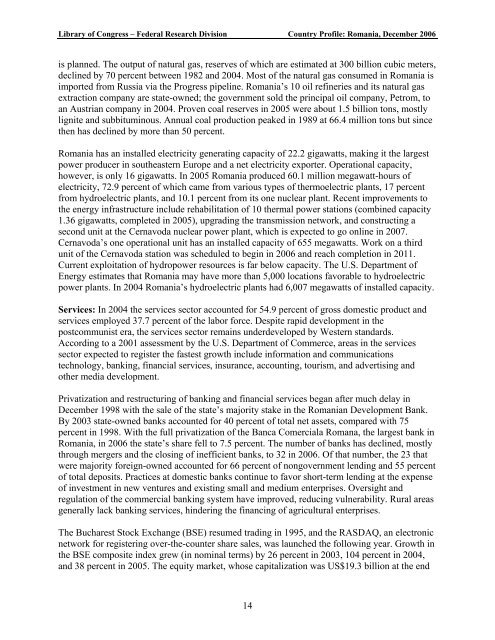Country Profile: Romania - Library of Congress
Country Profile: Romania - Library of Congress
Country Profile: Romania - Library of Congress
Create successful ePaper yourself
Turn your PDF publications into a flip-book with our unique Google optimized e-Paper software.
<strong>Library</strong> <strong>of</strong> <strong>Congress</strong> – Federal Research Division <strong>Country</strong> <strong>Pr<strong>of</strong>ile</strong>: <strong>Romania</strong>, December 2006<br />
is planned. The output <strong>of</strong> natural gas, reserves <strong>of</strong> which are estimated at 300 billion cubic meters,<br />
declined by 70 percent between 1982 and 2004. Most <strong>of</strong> the natural gas consumed in <strong>Romania</strong> is<br />
imported from Russia via the Progress pipeline. <strong>Romania</strong>’s 10 oil refineries and its natural gas<br />
extraction company are state-owned; the government sold the principal oil company, Petrom, to<br />
an Austrian company in 2004. Proven coal reserves in 2005 were about 1.5 billion tons, mostly<br />
lignite and subbituminous. Annual coal production peaked in 1989 at 66.4 million tons but since<br />
then has declined by more than 50 percent.<br />
<strong>Romania</strong> has an installed electricity generating capacity <strong>of</strong> 22.2 gigawatts, making it the largest<br />
power producer in southeastern Europe and a net electricity exporter. Operational capacity,<br />
however, is only 16 gigawatts. In 2005 <strong>Romania</strong> produced 60.1 million megawatt-hours <strong>of</strong><br />
electricity, 72.9 percent <strong>of</strong> which came from various types <strong>of</strong> thermoelectric plants, 17 percent<br />
from hydroelectric plants, and 10.1 percent from its one nuclear plant. Recent improvements to<br />
the energy infrastructure include rehabilitation <strong>of</strong> 10 thermal power stations (combined capacity<br />
1.36 gigawatts, completed in 2005), upgrading the transmission network, and constructing a<br />
second unit at the Cernavoda nuclear power plant, which is expected to go online in 2007.<br />
Cernavoda’s one operational unit has an installed capacity <strong>of</strong> 655 megawatts. Work on a third<br />
unit <strong>of</strong> the Cernavoda station was scheduled to begin in 2006 and reach completion in 2011.<br />
Current exploitation <strong>of</strong> hydropower resources is far below capacity. The U.S. Department <strong>of</strong><br />
Energy estimates that <strong>Romania</strong> may have more than 5,000 locations favorable to hydroelectric<br />
power plants. In 2004 <strong>Romania</strong>’s hydroelectric plants had 6,007 megawatts <strong>of</strong> installed capacity.<br />
Services: In 2004 the services sector accounted for 54.9 percent <strong>of</strong> gross domestic product and<br />
services employed 37.7 percent <strong>of</strong> the labor force. Despite rapid development in the<br />
postcommunist era, the services sector remains underdeveloped by Western standards.<br />
According to a 2001 assessment by the U.S. Department <strong>of</strong> Commerce, areas in the services<br />
sector expected to register the fastest growth include information and communications<br />
technology, banking, financial services, insurance, accounting, tourism, and advertising and<br />
other media development.<br />
Privatization and restructuring <strong>of</strong> banking and financial services began after much delay in<br />
December 1998 with the sale <strong>of</strong> the state’s majority stake in the <strong>Romania</strong>n Development Bank.<br />
By 2003 state-owned banks accounted for 40 percent <strong>of</strong> total net assets, compared with 75<br />
percent in 1998. With the full privatization <strong>of</strong> the Banca Comerciala Romana, the largest bank in<br />
<strong>Romania</strong>, in 2006 the state’s share fell to 7.5 percent. The number <strong>of</strong> banks has declined, mostly<br />
through mergers and the closing <strong>of</strong> inefficient banks, to 32 in 2006. Of that number, the 23 that<br />
were majority foreign-owned accounted for 66 percent <strong>of</strong> nongovernment lending and 55 percent<br />
<strong>of</strong> total deposits. Practices at domestic banks continue to favor short-term lending at the expense<br />
<strong>of</strong> investment in new ventures and existing small and medium enterprises. Oversight and<br />
regulation <strong>of</strong> the commercial banking system have improved, reducing vulnerability. Rural areas<br />
generally lack banking services, hindering the financing <strong>of</strong> agricultural enterprises.<br />
The Bucharest Stock Exchange (BSE) resumed trading in 1995, and the RASDAQ, an electronic<br />
network for registering over-the-counter share sales, was launched the following year. Growth in<br />
the BSE composite index grew (in nominal terms) by 26 percent in 2003, 104 percent in 2004,<br />
and 38 percent in 2005. The equity market, whose capitalization was US$19.3 billion at the end<br />
14

















